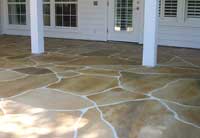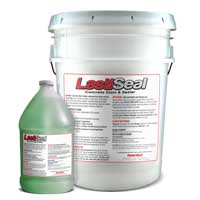About Chemical Acid Stains
Acid-based chemical stains have been used by decorative concrete contractors for many years. They work by reacting with alkalis in the concrete surface. This creates a translucent, variegated look. Acid stains do a wonderful job in beautifying indoor and outdoor concrete like driveways, concrete floors, pool decks, and counter tops. They are resistant to UV rays and wear. However, they have a few drawbacks:
- Corrosive components – including hydrochloric acid and chlorides. Personal protection required.
- A Multiple-Step Application – an experienced concrete decorator is recommended.
- Limited Choice in Color – colors are limited to earth tones and soft blues or greens.
Concrete Dyes and Stains
Concrete stains and dyes do not react with the concrete but use color pigments that penetrate into the surface. Their common features:
- Unlimited Color Palette – Color is practically unlimited because you can mix or dilute the colors.
- Easy and Safe Application – The application of water-based stains or dyes is easy and safe for contractors, as well as homeowners. They contain no or very low VOCs. A quick application with a low-pressure sprayer, roller, brush, or sponge.
About Concrete Dyes
Dyes are used to color most everyday products, including textiles, plastics, wood, paper, and food, as well as concrete. Natural dyes originate from plant sources like berries, roots, wood, and fungi. The invention of synthetic dyes has vastly increased the range of colors. Concrete dyes are readily available in stores in the form of liquid concentrates or powders. Dyes contain very fine color pigments, much smaller than stains. They are solutions, similar to ink, and can easily penetrate into tight concrete. Most are water-based but there also are solvent-based dyes, usually with acetone or alcohol.- Uniform Color – The resulting color is usually more uniform or monotone, unlike the variegated look of stains.
- Not UV-stable – Typically, dyes are not UV-stable and would fade in the sun in a couple months, which limits their use to indoors.
- Top coatings – most manufacturers recommend applying a clear sealer to lock in the color and protect against leaching.
About Concrete Stains
Stains are a suspension of color pigments. This is similar to paints but the stain pigments must be smaller to penetrate into the concrete instead of staying on the surface, or they would wear or wash off. Concrete stains are typically water-based and have none or a low VOC content. Easy and safe application.
More porous areas will absorb more pigments, making them darker. Tighter concrete will absorb less of the stain pigments. Hard-troweled concrete requires good surface preparation to open up the surface and make it sufficiently porous.
Stains provide a vibrant, variegated look on the concrete, similar to acid stains but with many more color options.

What Attacks Concrete Stains?
The first enemy is the sun. UV rays break down color pigments and dyes, making the colors fade. That’s why dyes should be used only indoors and the color pigments in outdoor stains should be UV-resistant. However, the biggest enemy of stains is water – it gradually breaks down concrete. Driveways, patios, pool decks, and foundation slabs are built from concrete, which is naturally porous. The pores draw in groundwater by wicking action and dissolve the minerals inside concrete, making it more and more porous. Migrating groundwater brings dissolved salts to the surface, where they attack any stain, chemical or water-based. As the water evaporates, it leaves behind the salts as unsightly whitish spots (“efflorescence”) on the stained concrete. Water vapor from the ground easily oozes through the pores in concrete. Stains are usually covered with a transparent sealer for enhanced appearance and wear protection. But this top coatings may trap water vapor, which activates efflorescence and discolors the stain. After couple years, the attractive stained look may turn to a uniform, dull color.The Latest in Concrete Stains
You can protect stained concrete against surface water, snow, and ice with a clear coating readily available in stores. However, this will not protect the stain against groundwater, water vapor, and efflorescence rising from below.
The latest but already well-proven technology combines staining with waterproofing – the LastiSeal Concrete Stain & Sealer.
What makes LastiSeal™ Stain & Concrete Sealer so special?
LastiSeal is a combination of concrete stains and a waterproofing sealer. The stain uses UV-resistant mineral pigments. The finely ground pigments allow it to penetrate into smaller pores in the surface. Water-based and ultra-low VOCs for a safe application.
The LastiSeal deep-penetrating sealer penetrates 2 – 4 inches into the concrete and hardens, waterproofing the concrete permanently. It protects the concrete against deterioration, spalling or pitting due to freeze-thaw cycles, road salts, and most chemical spills. In addition, it protects the stain against groundwater and moisture vapor from below. The stain, as well as the concrete, will last much longer.
You can choose from 37 different colors, more than any other stain.
LastiSeal™ Concrete Stain & Sealer – concrete waterproofing and staining in one step!
